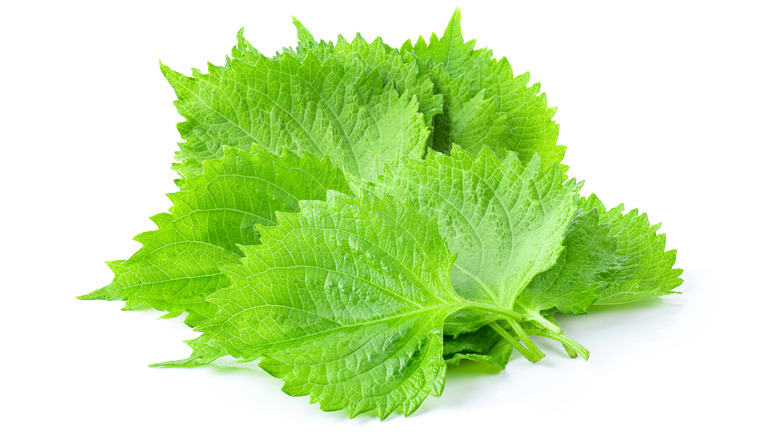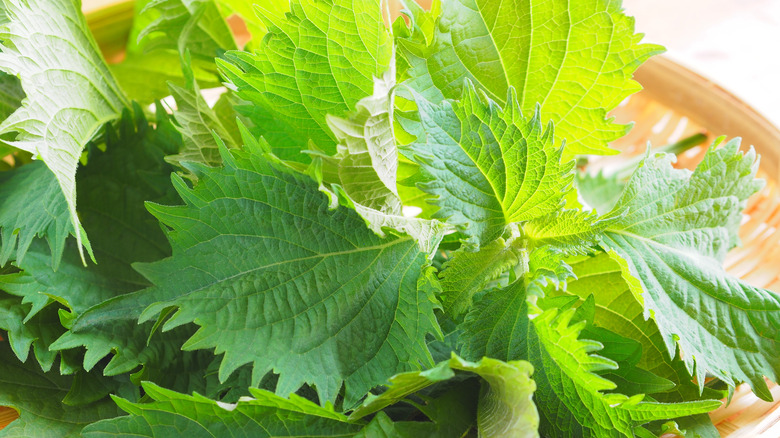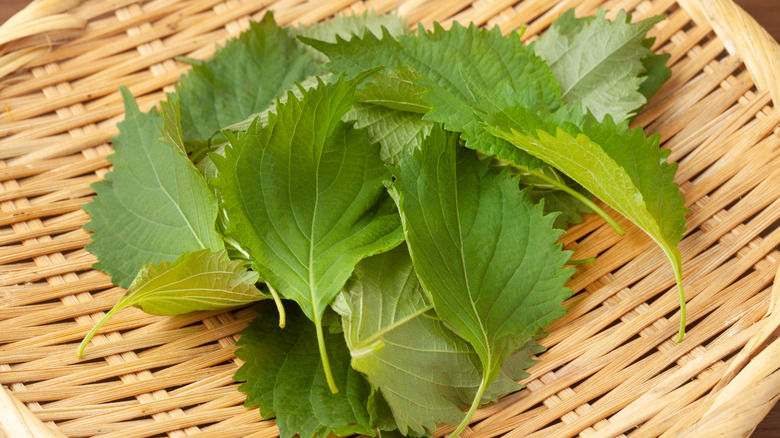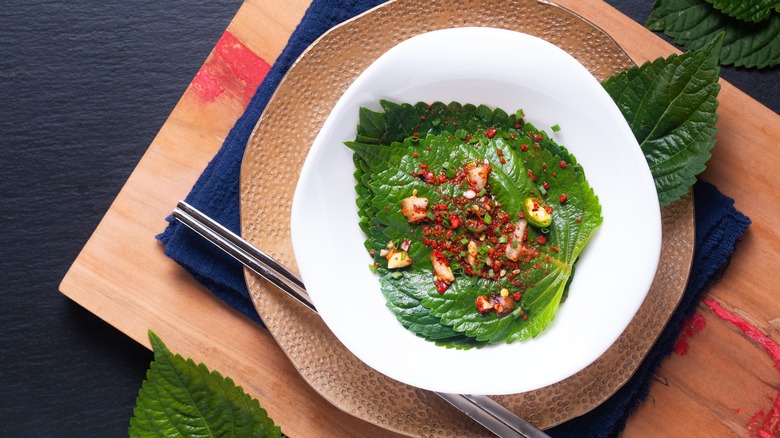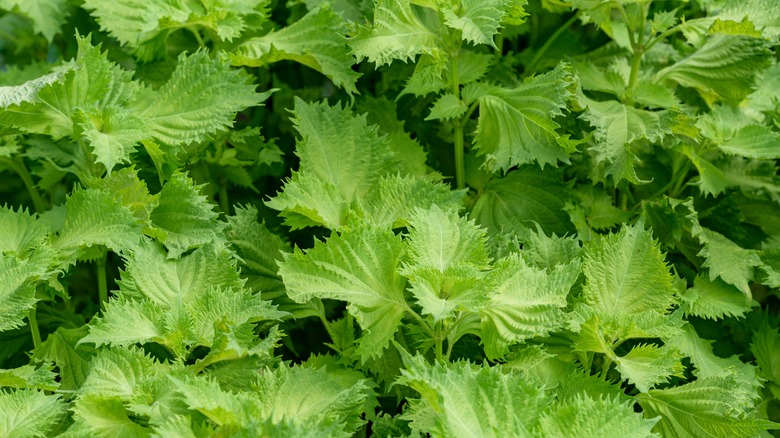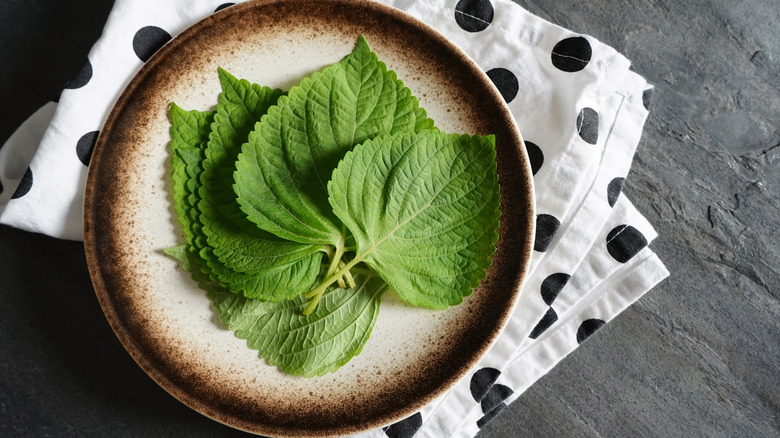Shiso Leaves: More Than Just A Pretty Decoration On Your Sushi Platter
Sure, cilantro may be polarising, but most other green garnishes fly under the radar. However, with their potent flavor and large size, that's not the case with shiso leaves. Most frequently seen as a serving platter for sushi in the U.S., this leaf actually possesses a much more varied role in the kitchen.
Used for centuries across many countries in Asia, shiso leaves are added to soups, pickled, fried, and even turned into an oil. Tangy, sometimes spicy, and refreshing, shiso leaves are like a large, more intensified mint. Esteemed for their medicinal qualities, the plant not only wards off other bacteria but also eases inflammation and stomach ailments. Plus, shiso leaves are so easily grown, some states in the U.S consider them an invasive species. However, if they're not so common in your kitchen, it's time for that to change — here's what the pleasant-looking plant is all about.
What are shiso leaves?
Shiso, botanically classified as Perilla frutescens, is a leafy plant in the mint family. About the size of a human hand, shiso is known for its chiseled exterior shape and strong, but tasty flavor. Although the plant exists in a red version and a dual-color hybrid, the green variety is favored. Typically, the redder the color, the less palatable the flavor; however, vivid varieties are often used as a dye and colorant in applications.
Shiso is endemic to the Himalayas and Southeast Asia, although it has spread across the globe. Referred to by many different names, such as Lá Tía Tô in Vietnamese or Kkaennip in Korean, the shiso plant has a diverse array of culinary uses. However, due to associations with Japanese cuisine, shiso is the most common name in the U.S. In gardening contexts, the plant is also called perilla or beefsteak. Let's dive into how shiso leaves taste.
Shiso leaves' flavor and antibacterial qualities
Shiso exhibits a potent but palatable flavor; if used incorrectly, it can be overpowering. The taste varies on the type — typically, there's a citrus-like tartness accompanied by a strong spice akin to cinnamon or cumin. Like its mint relative, it has a refreshing character with a dash of heat that's reminiscent of peppermint. This intensity may be accompanied by a bitter quality, which is present in darker varieties. Texturally, shiso is similar to mint and other herbs, but with a thicker density.
Durable and large, shiso leaves are often utilized as wrappers to separate food. Covering fish and meat in Vietnam, or propping sushi in Japan, this functional application is also for preservation. Due to a compound called phytoncide, Shiso possesses antibacterial qualities that reduce food spoilage. In fact, the green chiseled plastic liner in sushi containers was created to mimic shiso leaves! Although handy, separating foods is only a fraction of their uses in the kitchen — let's explore additional dishes.
Shiso leaves' culinary uses
Especially In Japan, shiso leaves are most frequently consumed raw. Like other fresh herbs, they can add a bright and floral note to a salad or be wrapped inside of a spring roll. They're integrated into sushi and can accompany a tartare since the flavor pairs well with raw fish. However, sweet renditions with the leaf exist too — they often wrap red-bean filled mochi. Like mint, their freshness can also be integrated into drinks, including cocktails, shaved ice, and syrups. Sake producers reach for the red variety to impart bright color. For their dyeing effect, shiso leaves are also used to make Japanese pickled plums.
When it comes to cooking shiso, the most well-known form is when they're deep-fried into tempura. In Korea, they are also pan-fried, functioning as a crispy wrapper for beef and tofu. Shiso leaves are also served as a common Korean banchan, prepared through a pickling process with chilies, garlic, and soy sauce. And for a nurturing meal, they can even be mixed into a soup.
In addition to leaves, shiso can be used other forms, too. It's sometimes pressed into an oil, which can be used in confectionery and alcoholic creations. And in a few Indian provinces, the seeds are roasted and ground into chutneys. Once accustomed to their potent flavor, the applications are numerous.
Nutrition of shiso leaves
In addition to their antibacterial qualities, shiso leaves offer some beneficial nutritional qualities. They've long been used in Chinese traditional medicine, most frequently favored as a way to ease colds. Such health benefits have been backed by scientific research. Due to an abundance of omega acids, perilla extract aids against inflammation, heart conditions, allergies, and asthma, per the National Library of Medicine. Additionally, flavonoids found in shiso leaves offer digestive relief, improving bloating and other stomach discomforts, via Pots and Pans. Plus, the plant also contains fiber — with a 100-gram serving offering up to a third of a daily serving. And, such benefits are all offered despite a low-calorie count: only 37 calories in a 100-gram serving, notes Live Strong.
Just as shiso leaves stop bacteria from infesting foods, it does the same for teeth. An extract from the leaf called luteolin aids with cavity prevention. Shiso leaves have also shown an ability to minimize infections like Staphylococcus, notes Drugs.com.
Where to buy and how to store shiso leaves
With their expanding popularity, shiso leaves can be found in most Asian groceries in the U.S. — Japanese and Korean-focused suppliers are especially good starting points for purchase. In addition, shiso leaves can be purchased online, in both fresh and pickled forms. They're also sold frozen and dried, although their flavors are muted when not fresh. For those with garden space, growing shiso is another viable alternative. The plant survives through both hot and cold conditions and does not require much maintenance. Plus, as soon as leaves appear, they can be consumed.
Once purchased, shiso quickly loses its freshness. Even if properly stored, it'll go bad after only a couple of days — so attempt to use it right after acquiring a bundle. The plant tends to go dry, so wrap in a moist paper towel and place it into an airtight container. Dried shisho has a better shelf life, and can be held in the same space as other dehydrated spices.
